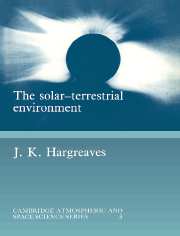 The Solar-Terrestrial Environment
The Solar-Terrestrial Environment Book contents
- Frontmatter
- Contents
- Preface
- 1 The Earth in space
- 2 The physics of geospace
- 3 Techniques for observing geospace
- 4 The neutral atmosphere
- 5 The solar wind and the magnetosphere
- 6 Principles of the ionosphere at middle and low latitudes
- 7 Ionospheric phenomena at middle and low latitudes
- 8 The ionosphere at high latitude
- 9 Magnetospheric waves
- 10 Technological application of geospace science
- Index
2 - The physics of geospace
Published online by Cambridge University Press: 29 January 2010
- Frontmatter
- Contents
- Preface
- 1 The Earth in space
- 2 The physics of geospace
- 3 Techniques for observing geospace
- 4 The neutral atmosphere
- 5 The solar wind and the magnetosphere
- 6 Principles of the ionosphere at middle and low latitudes
- 7 Ionospheric phenomena at middle and low latitudes
- 8 The ionosphere at high latitude
- 9 Magnetospheric waves
- 10 Technological application of geospace science
- Index
Summary
Someone told me that each equation I included in the book would halve the sales.
S. W. Hawking, A Brief History of Time (1988)(Health warning – This chapter has more equations than any other.)
The purpose of this chapter is to summarize points of physics that will be needed in order to grasp the fundamentals of geospace science. It is assumed that the student is already familiar with basic physical concepts such as energy, temperature, quanta, waves, molecules, heat, and electric and magnetic fields – topics, it will be noted, which come mainly within the domain of classical physics. Most students of physics will have covered these areas in the first year or two of their university courses. But, like most specialities, upper atmosphere and space science have their own peculiar slant. We have to deal with a gas, and in particular with an electrified gas. We will be concerned with the propagation of waves – mainly electromagnetic waves, but some others too – in that gas. We shall need to know how a steady magnetic field affects the behaviour of gas and of waves. Energetic particles and photons will enter the gas, and their interactions have to be included. So the present chapter outlines the relevent background. Much of the material should be revision but some may be new.
It is up to the student whether to study this chapter thoroughly before tackling the subsequent ones, or merely to scan it through now in order to return for clarification later, if and when questions arise.
- Type
- Chapter
- Information
- The Solar-Terrestrial EnvironmentAn Introduction to Geospace - the Science of the Terrestrial Upper Atmosphere, Ionosphere, and Magnetosphere, pp. 6 - 43Publisher: Cambridge University PressPrint publication year: 1992


